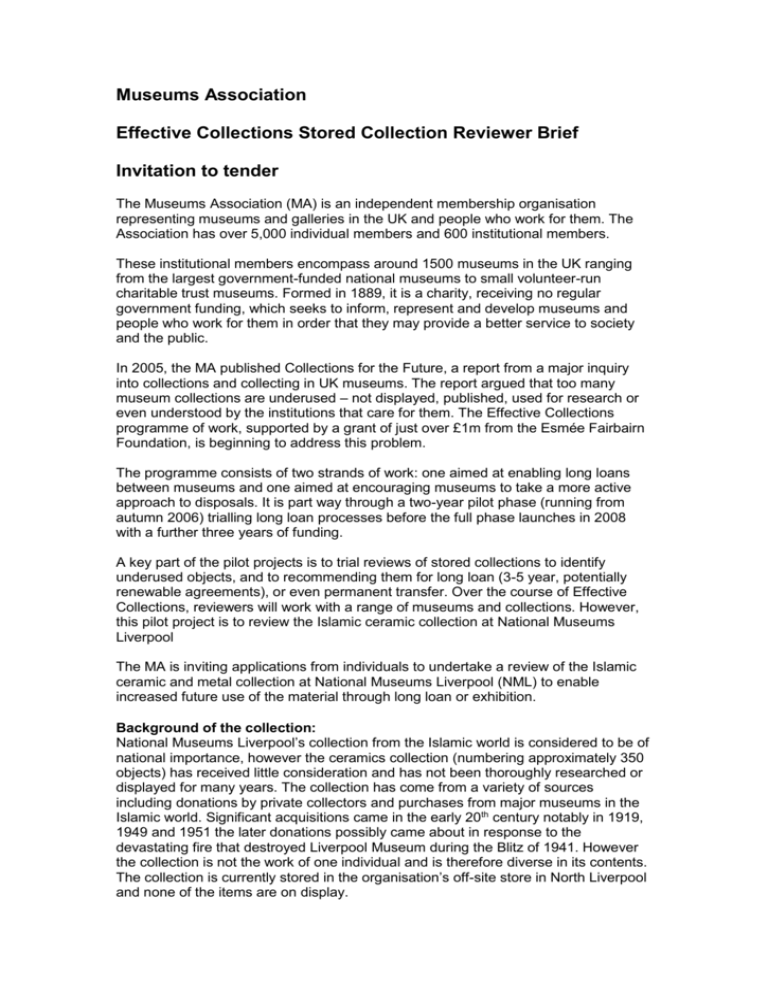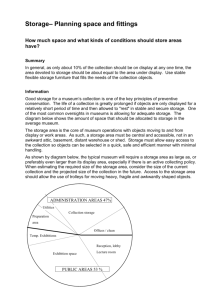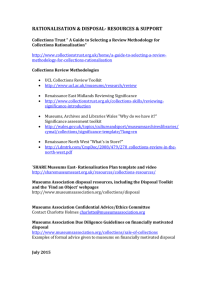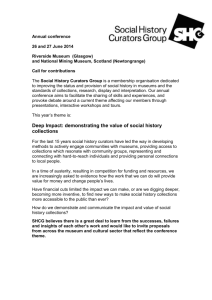Stored Collection Reviewer person specification
advertisement

Museums Association Effective Collections Stored Collection Reviewer Brief Invitation to tender The Museums Association (MA) is an independent membership organisation representing museums and galleries in the UK and people who work for them. The Association has over 5,000 individual members and 600 institutional members. These institutional members encompass around 1500 museums in the UK ranging from the largest government-funded national museums to small volunteer-run charitable trust museums. Formed in 1889, it is a charity, receiving no regular government funding, which seeks to inform, represent and develop museums and people who work for them in order that they may provide a better service to society and the public. In 2005, the MA published Collections for the Future, a report from a major inquiry into collections and collecting in UK museums. The report argued that too many museum collections are underused – not displayed, published, used for research or even understood by the institutions that care for them. The Effective Collections programme of work, supported by a grant of just over £1m from the Esmée Fairbairn Foundation, is beginning to address this problem. The programme consists of two strands of work: one aimed at enabling long loans between museums and one aimed at encouraging museums to take a more active approach to disposals. It is part way through a two-year pilot phase (running from autumn 2006) trialling long loan processes before the full phase launches in 2008 with a further three years of funding. A key part of the pilot projects is to trial reviews of stored collections to identify underused objects, and to recommending them for long loan (3-5 year, potentially renewable agreements), or even permanent transfer. Over the course of Effective Collections, reviewers will work with a range of museums and collections. However, this pilot project is to review the Islamic ceramic collection at National Museums Liverpool The MA is inviting applications from individuals to undertake a review of the Islamic ceramic and metal collection at National Museums Liverpool (NML) to enable increased future use of the material through long loan or exhibition. Background of the collection: National Museums Liverpool’s collection from the Islamic world is considered to be of national importance, however the ceramics collection (numbering approximately 350 objects) has received little consideration and has not been thoroughly researched or displayed for many years. The collection has come from a variety of sources including donations by private collectors and purchases from major museums in the Islamic world. Significant acquisitions came in the early 20th century notably in 1919, 1949 and 1951 the later donations possibly came about in response to the devastating fire that destroyed Liverpool Museum during the Blitz of 1941. However the collection is not the work of one individual and is therefore diverse in its contents. The collection is currently stored in the organisation’s off-site store in North Liverpool and none of the items are on display. The collection includes: Pottery Sherds: over 70 pieces collected during archaeological digs in the important Egyptian trading port of Fostat. Modern examples: A small number of tourist pieces and two interesting groups of terracottas including early 20th century Assuit ware from Egypt and three large vessels created by a female Christian potter in Ramallah. Lustre and Faience tiles: A group of tiles, some mounted, from Iran and Turkey. Vessel: A selection of vessels from a variety of countries including Turkey, Iran and Syria Please note documentation on the collection is still underway. The above details are subject to change. Documentation of the collection: The ceramics collection is currently being unpacked and documented creating basic ‘core’ records for the collection on NML’s computerised database MIMSY. There are also record cards for individual items and in some cases there are history files with information relating to the donor and the acquisition of the object. Any reviewer would therefore not be required to document the collection, but would give an assessment on the level of documentation required for the collection to be useful. Also advise on the technical terminology used in the documentation. Outcomes 1. To long lend for display 10 or more objects from the collection to publicly accessible locations. 2. To make the collection more accessible for future use. 3. Raise awareness of the collection within the profession and to stakeholders. 4. Improve professional knowledge of subject area and resources available. 5. Build knowledge of significance of the collection in relation to North-West and national museum context. 6. Support NML’s strategic collections development plan. Stored Collection Reviewer activities 1. Assess current items in the collection and reveal strengths and weaknesses of the subject area. 2. Review the potential of the collection for display. 3. Advise on potential objects for loan. 4. Advise on non-museum organisations or educational opportunities where collection might be of use. 5. Assess current collections care for these items (storage, health & safety issues, pests). 6. Review terminology of documentation and advise on the correct use. Stored Collection Reviewer person specification 1. An understanding of and experience of working with Islamic collections, with specialist expertise in accordance with point 2 of the reviewer activities above. 2. Knowledge of Islamic ceramic collections in the UK, and particularly the North-West. 3. 4. 5. Knowledge of specialist groups and educational institutions interested in Islamic collections in the UK, and particularly the North-West. Experience caring for ceramic collections, considering their storage, handling and display requirements. Enthusiasm for Islamic collections and their wider use. Timescale and fees The stored collections reviewer will be contracted at a daily rate of £200, with the work expected to take five days (3-4 days at the museum and 1-2 days for additional research and report production). An additional two days is available with further negotiation, dependent upon the proportion of the collection that the reviewer has the expertise to include. This will include all expenses apart from travel, to be agreed separately. The review is expected to take place between April and June 2008 at a time agreed between the curator and NML and the appointed reviewer. Reporting The stored collection reviewer is required to provide a concise report covering the following areas: 1. Specific objects or groups of objects that are strengths of the collection for: a) local relevance; b) national relevance; c) subject specialism. 2. Objects or groups of objects that do not have local, national or subject specialist relevance. For example, samples of poor quality or not to museum standard for another reason. 3. Recommendations based on the above two criteria about uses of the collections for: a) display at NML; b) display at alternative museum and non-museum locations; c) use in other ways, perhaps by specialist groups. 4. Suggest where to lend objects to, where possible. 5. Strengths and weaknesses of current storage and collections care, recommending improvements where appropriate. 6. Advise on correct use of terminology. Applications Applications to undertake the stored collection review at National Museums Liverpool should be received by 11 April 2008. Shortlisted candidates will be contacted by 25 April 2008. Please send a covering letter addressing the person specification above and a CV to Sally Cross at sally@museumsassociation.org or Museums Association, 24 Calvin Street, London E1 6NW. For an informal conversation about the reviewer role contact Sally on 020 7426 6933.







